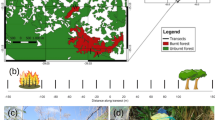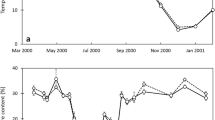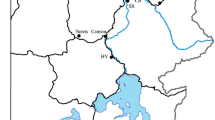Abstract
Dry woodlands frequently experience fire, and the heterogeneous spatial patterning of vegetation cover and fire behavior in these systems can lead to interspersed burned and unburned patches of different vegetation cover types. Biogeochemical processes may differ due to fire and vegetation cover influences on biotic and abiotic conditions, but these persistent influences of fire in the months or years following fire are not as well understood as the immediate impacts of fire. In particular, leaf litter decomposition, a process controlling nutrient availability and soil organic matter accumulation, is poorly understood in drylands but may be sensitive to vegetation cover and fire history. Decomposition is responsive to changes in abiotic drivers or interactions between abiotic conditions and biotic drivers, suggesting that decomposition rates may differ with vegetation cover and fire. The objective of this study was to assess the role of vegetation cover and fire on leaf litter decomposition in a semi-arid pinyon-juniper woodland in southern New Mexico, USA, where prescribed fire is used to combat increasing woody cover. A spatially heterogeneous prescribed burn led to closely co-located but discrete burned and unburned patches of all three dominant vegetation cover types (grass, shrub, tree). Decomposition rates of leaf litter from two species were measured in mesh litterbags deployed in factorial combination of the three vegetation cover types and two fire treatments (burned and unburned patches). For both litter types, decomposition was lower for unburned trees than for unburned grass or shrubs, perhaps due to greater soil–litter mixing and solar radiation away from tree canopies. Fire enhanced litter mass loss under trees, making decomposition rates similarly rapid in burned patches of all three vegetation cover types. Understanding decomposition dynamics in spatially heterogeneous vegetation cover of dry woodlands is critical for understanding biogeochemical process responses to fire in these systems.



Similar content being viewed by others
References
Aerts R (1997) Climate, leaf litter chemistry, and leaf litter decomposition in terrestrial ecosystems: a triangular relationship. Oikos 79:439–449
Allen AP, Gillooly JF, Brown JH (2005) Linking the global carbon cycle to individual metabolism. Funct Ecol 19:202–213
Archer S, Davies K, Fulbright TE, McDaniel KC, Wilcox BP, Predick KI (2011) Brush management as a rangeland conservation tool: a critical evaluation. In: Briske D (ed) Conservation benefits of rangeland practices: assessment, recommendations, and knowledge gaps. United States Department of Agriculture, Washington
Austin AT, Mendez MS, Ballare CL (2016) Photodegradation alleviates the lignin bottleneck for carbon turnover in terrestrial ecosystems. Proc Natl Acad Sci USA 113:4392–4397
Barnes PW, Throop HL, Hewins DB, Abbene ML, Archer SR (2012) Soil coverage reduces photodegradation and promotes the development of soil-microbial films on dryland leaf litter. Ecosystems 15:311–321
Barnes PW, Throop HL, Archer SR, Breshears DD, McCulley RL, Tobler MA (2015) Sunlight and soil-litter mixing: drivers of litter decomposition in drylands. Prog Bot 76:273–302
Barron-Gafford GA, Scott RL, Jenerette GD, Huxman TE (2011) The relative controls of temperature, soil moisture, and plant functional group on soil CO2 efflux at diel, seasonal, and annual scales. J Geophys Res 116:G01023
Brennan KEC, Christie FJ, York A (2009) Global climate change and litter decomposition: more frequent fire slows decomposition and increases the functional importance of invertebrates. Glob Chang Biol 15:2958–2971
Certini G (2005) Effects of fire on properties of forest soils: a review. Oecologia 143:1–10
Crow SE, Lajtha K, Filley TR, Swanston CW, Bowden RD, Caldwell BA (2009) Sources of plant-derived carbon and stability of organic matter in soil: implications for global change. Glob Chang Biol 15:2003–2019
Day TA, Guénon R, Ruhland CT (2015) Photodegradation of plant litter in the Sonoran Desert varies by litter type and age. Soil Biol Biochem 89:109–122
Fusco EJ, Abatzoglou JT, Balch JK, Finn JT, Bradley BA (2016) Quantifying the human influence on fire ignition across the western USA. Ecol Appl 26:2388–2399
Harris D, Horwath WR, van Kessel C (2001) Acid fumigation of soils to remove carbonates prior to total organic carbon or carbon-13 isotopic analysis. Soil Sci Soc Am J 65:1853–1856
Hernández DL, Hobbie SE (2008) Effects of fire frequency on oak litter decomposition and nitrogen dynamics. Oecologia 158:535–543
Hewins DB, Throop HL (2016) Leaf litter decomposition is rapidly enhanced by the co-occurrence of monsoon rainfall and soil-litter mixing across a gradient of coppice dune development in the Chihuahuan Desert. J Arid Environ 129:111–118
Hewins DB, Archer SR, Okin GS, McCulley RL, Throop HL (2013) Soil-litter mixing accelerates decomposition in a Chihuahuan Desert grassland. Ecosystems 16:183–195
Hewins DB, Sinsabaugh RL, Archer SR, Throop HL (2017) Soil-litter mixing and microbial activity mediate decomposition and soil aggregate formation in a sandy shrub-invaded Chihuahuan Desert grassland. Plant Ecol 218(4):459–474
Hobbie SE (1992) Effects of plant species on nutrient cycling. Trends Ecol Evol 7:336–339
Hobbie SE, Vitousek PM (2000) Nutrient limitation of decomposition in Hawaiian forests. Ecology 81:1867–1877
Huffman DW, Fulé PZ, Crouse JE, Pearson KM (2009) A comparison of fire hazard mitigation alternatives in pinyon–juniper woodlands of Arizona. Forest Ecol Manag 257:628–635
Johansen MP, Hakonson TE, Breshears DD (2001) Post-fire runoff and erosion from rainfall simulation: contrasting forests with shrublands and grasslands. Hydrol Process 15:2953–2965
Kay AD, Mankowski J, Hobbie SE (2008) Long-term burning interacts with herbivory to slow decomposition. Ecology 89:1188–1194
King JY, Brandt LA, Adair EC (2012) Shedding light on plant litter decomposition: advances, implications and new directions in understanding the role of photodegradation. Biogeochemistry 111:57–81
Klemmedson JO, Tiedemann AR (2000) Influence of western juniper development on distribution of soil and organic layer nutrients. Northwest Sci 74:1–11
Lee H, Rahn T, Throop HL (2012) An accounting of C-based trace gas release during abiotic plant litter degradation. Glob Chang Biol 18:1185–1195
Lee H, Fitzgerald J, Hewins DB, McCulley RL, Archer SR, Rahn T, Throop HL (2014) Soil moisture and soil-litter mixing effects on surface litter decomposition: a controlled environment assessment. Soil Biol Biochem 72:123–132
Littell JS, Peterson DL, Riley KL, Liu YQ, Luce CH (2016) A review of the relationships between drought and forest fire in the United States. Glob Chang Biol 22:2353–2369
Miller R, Rose J (1999) Fire history and western juniper encroachment in sagebrush steppe. J Range Manag 52:550–559
Miller RF, Tausch RJ (2001) The role of fire in pinyon and juniper woodlands: a descriptive analysis. In: Galley KEM, Wilson TP (eds) Fire conference 2000: the first national congress on fire ecology, prevention, and management. Tall Timbers Research Station, Tallahassee, pp 15–30
Monleon VJ, Cromack K (1996) Long-term effects of prescribed underburning on litter decomposition and nutrient release in ponderosa pine stands in central Oregon. For Ecol Manag 81:143–152
Naito AT, Cairns DM (2011) Patterns and processes of global shrub expansion. Prog Phys Geog 35:423–442
Okin GS, Heras MMDL, Saco PM, Throop HL, Vivoni ER, Parsons AJ, Wainwright J, Peters DPC (2015) Connectivity in dryland landscapes: shifting concepts of spatial interactions. Front Ecol Environ 13:20–27
Parton W, Silver WL, Burke IC, Grassens L, Harmon ME, Currie WS, King JY, Adair EC, Brandt LA, Hart SC, Fasth B (2007) Global-scale similarities in nitrogen release patterns during long-term decomposition. Science 315:361–364
Pucheta E, Llanos M, Meglioli C, Gaviorno M, Ruiz M, Parera C (2006) Litter decomposition in a sandy Monte desert of western Argentina: influences of vegetation patches and summer rainfall. Austral Ecol 31:808–816
Romme WH, Allen CD, Balley JD, Baker WL, Bestelmeyer BT, Brown PM, Eisenhart KS, Floyd ML, Huffman DW, Jacobs BF, Miller RF, Muldavin EH, Swetnam TW, Tausch RJ, Weisberg PJ (2009) Historical and modern disturbance regimes, stand structures, and landscape dynamics in piñon-juniper vegetation of the western United States. RangelEcol Manag 62:203–222
Springett JA (1976) Effect of prescribed burning on soil fauna and on litter decomposition in Western Australia forests. Aust J Ecol 1:77–82
Stark NM (1977) Fire and nutrient cycling in a Douglas-fir/larch forest. Ecology 58:16–30
Throop HL, Archer SR (2007) Interrelationships among shrub encroachment, land management, and litter decomposition in a semidesert grassland. Ecol Appl 17:1809–1823
Throop HL, Archer SR (2009) Resolving the dryland decomposition conundrum: some new perspectives on potential drivers. Prog Bot 70:171–194
van Asperen H, Warneke T, Sabbatini S, Nicolini G, Papale D, Notholt J (2015) The role of photo- and thermal degradation for CO2 and CO fluxes in an arid ecosystem. Biogeosciences 12:4161–4174
Van Auken OW (2009) Causes and consequences of woody plant encroachment into western North American grasslands. J Environ Manag 90:2931–2942
Wardle DA, Bonner KI, Barker GM, Yeates GW, Nicholson KS, Bardgett RD, Watson RN, Ghani A (1999) Plant removals in perennial grassland: vegetation dynamics, decomposers, soil biodiversity, and ecosystem properties. Ecol Monogr 69:535–568
Whitford WG, Meentemeyer V, Seastedt TR, Cromack K, Crossley DA, Santos P, Todd RL, Waide JB (1981) Exceptions to the AET model—deserts and clear-cut forest. Ecology 62:275–277
Zhang QH, Zak JC (1995) Effects of gap size on litter decomposition and microbial activity in a subtropical forest. Ecology 76:2196–2204
Acknowledgements
We thank the staff of the San Andres National Wildlife Refuge, in particular M. Weisenberger, for facilitating work at this site. We appreciate field and laboratory assistance from J. Fitzgerald, D. Hewins, and J. Smith. Funding for this work was from the International Arid Lands Consortium and the United States National Science Foundation (DEB 0815808 and 0953864). We appreciate constructive comments from two anonymous reviewers.
Author information
Authors and Affiliations
Corresponding author
Additional information
Communicated by Paul M. Ramsay.
Rights and permissions
About this article
Cite this article
Throop, H.L., Abu Salem, M. & Whitford, W.G. Fire enhances litter decomposition and reduces vegetation cover influences on decomposition in a dry woodland. Plant Ecol 218, 799–811 (2017). https://doi.org/10.1007/s11258-017-0730-1
Received:
Accepted:
Published:
Issue Date:
DOI: https://doi.org/10.1007/s11258-017-0730-1




